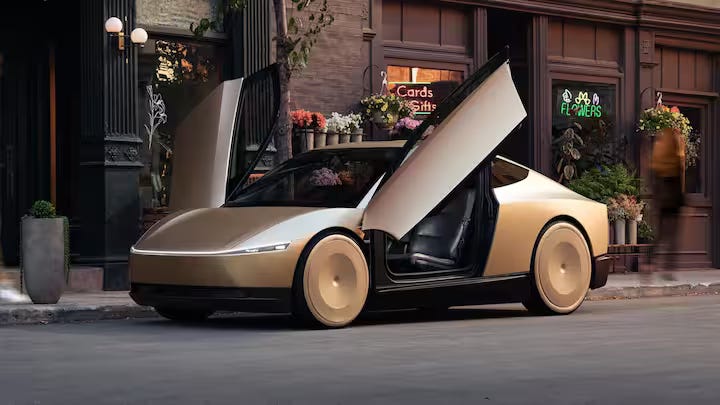Tesla’s Robotaxi Gamble: How the Next Five Years Could Upend Ownership, Ride-Hailing, and Automotive Economics
The Competitive Map: Who’s Actually Competing?
What happens when your car makes money while you sleep and what legacy OEMs should fear most.
Tesla’s self-driving taxi service goes live in Austin next month. Not as a lab test. Not in simulation. Live cars. Real passengers. No drivers.
The headlines are already here. What’s missing is the deeper story:
Tesla won’t own all the robotaxis. You might.
This service won’t look like Uber. It’ll compete with Uber.
And over the next five years, it could erase the dividing line between car owners and fleet operators.
This blog explores what’s happening now and what’s coming next.
From Parking to Profit: Tesla’s Hybrid Robotaxi Model
At the center of this rollout is an idea Elon Musk has teased for years: if your car can drive itself, why shouldn’t it work for you when you’re not using it?
The Tesla robotaxi network launching in June 2025 in Austin isn’t just a driverless fleet—it’s a flexible asset-sharing platform. Just like Airbnb turned homes into rental properties, Tesla wants to turn cars into autonomous, on-demand businesses.
“We’ll start with probably 10 [cars] for a week, then increase to 20, 30, 40. I think we’ll be at 1,000 within a few months,” Musk said.
“It’s a combination of a Tesla-owned fleet and also enabling Tesla owners to be able to add or subtract their car to the fleet.”
— Elon Musk, May 2025
Think of it like this:
You drive your Model Y to work at 8 a.m.
At 8:15, your car becomes a robotaxi, handling airport runs, lunch pickups, or school drop-offs—on its own
By 5 p.m., it’s back in your driveway, ready to drive you home
The day’s earnings are deposited automatically
This model shifts car ownership from cost center to cash flow engine—without lifting a finger.
Why Tesla Has a Head Start
Tesla isn’t first to the robotaxi table. Waymo, Cruise, and Zoox have all launched in limited cities with purpose-built AVs.
But Tesla has four distinct advantages:
Most importantly, Tesla is the only OEM offering autonomous ride-hailing to consumers, not just fleets. This gives them the potential to scale faster than any other player—without waiting for public-private partnerships or local lobbying.
The Competitive Map: Who’s Actually Competing?
Tesla’s real competition isn’t other car companies. It’s platforms.
Tesla, on the other hand, is building a closed-loop ecosystem:
Cars → Owners → Autonomy → Platform → Revenue → Upgrades → Loyalty.
Uber was never built for this.
Traditional automakers can’t respond quickly enough.
And Alphabet doesn’t sell cars.
Economic Impact: How the Numbers Could Work
If Tesla’s robotaxi platform works as promised, car ownership becomes a cash-generating asset.
Assume a vehicle can:
Complete 30 rides per day at $10 net revenue
Operate 20 days/month when idle from personal use
That’s $6,000/month gross, or around $3,000–$4,000/month net to the owner—before wear, taxes, and Tesla’s cut.
Even if those numbers are halved, it’s enough to:
Offset a lease or loan entirely
Make EVs more affordable to middle-class buyers
Change the buyer equation from “Can I afford this?” to “How much will it earn?”
For many buyers, Tesla’s real pitch won’t be the software it’ll be the ROI on ownership.
Regulatory + Risk Outlook: What Could Go Wrong?
Tesla still has hurdles to clear:
FSD is not yet Level 4 approved in most jurisdictions
Insurance models for private robotaxi vehicles are still unproven
Liability in autonomous crashes is a legal gray area
Musk insists Tesla will prove safety through data, noting FSD miles have already shown lower incident rates per mile than human drivers. Still, regulators will be watching and lawsuits will come.
Expect:
Opt-in cities first, like Austin and Miami
Geo-fenced service areas, especially in high-traffic, low-speed zones
Real-time monitoring via Tesla HQ, with interventions if needed
Tesla’s challenge isn’t technical. It’s trust.
Prediction: What the Next 5 Years Will Look Like
Here’s how this could play out by 2030:
2025:
Robotaxi launches in Austin, with gradual expansion
Owners begin reporting income from shared rides
Tesla releases a dedicated Robotaxi vehicle ("Cybercab")
2026–2027:
Tesla expands to 10+ U.S. cities
Insurance firms roll out AV-specific policies
Cities begin zoning and taxing robotaxi operations
2028–2029:
Legacy automakers attempt their own shared autonomy networks
Tesla surpasses Uber in number of U.S. rides in key cities
State-level legislation emerges to protect or restrict AV fleets
2030:
5–10% of all Teslas on the road are monetized part-time
Tesla introduces revenue-sharing tier into its purchase options
Autonomous vehicle income becomes part of car valuation
By the end of the decade, owning a Tesla could be as much about cash flow as convenience. For the first time, cars aren’t just a cost they’re a passive asset.
Final Word
Tesla's robotaxi rollout isn’t just a technology play. It’s an economic reset.
It challenges:
The notion that car ownership is a personal, static experience
The belief that autonomy is always five years away
The power structure of mobility itself
And if Elon Musk is right, the next big side hustle might not be delivering food, flipping sneakers, or renting your spare bedroom.
It might be letting your car work a 9-to-5 without you in it.
Want more insights like this?
Subscribe to Automotive Risk for weekly briefings on where the auto industry is going—and what risks are worth betting on.







